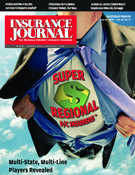Government scientists believe small unmanned airplanes sent to hurricanes’ cores could lead to revolutionary advances in storm forecasting and measurement.
The drones are able to fly far lower than manned hurricane hunter planes and can beam back information from close to the ocean’s surface, where conditions fuel a storm’s intensity. The National Oceanic and Atmospheric Administration began using drones in 2005, and they’ve proved effective.
“It’s going to be a revolution in earth system monitoring,” said Marty Ralph, who heads NOAA’s unmanned aircraft efforts. “Like the development of satellites in the 60s and 70s and of weather radar in the 30s and 40s, both of which are fundamental elements of our weather measurement and prediction, it’s in the same class.”
Until now, scientists relied solely on hurricane hunters that typically fly at 10,000 feet, though sometimes as low as 5,000 feet, and drop measuring instruments to the ocean. The instruments are unable to provide consistent readings from close to the water’s surface.
The drones fly as low as 300 feet and can go more than 2,000 miles without refueling. The probes on board are not as high-frequency as those on manned flights, but because of their consistent readings from a low altitude, they’ve been able to give scientists valuable data they’ve never before been able to gather.
Scientists don’t envision the $50,000 drones will replace manned flights. They say they can work in tandem to help plot the most crucial spots in a storm. Within a few years, Ralph said, he expects drones to be dispatched in every storm.
Was this article valuable?
Here are more articles you may enjoy.


 Severity Was Up, But Will Falling Claims Volume Impact the Profession?
Severity Was Up, But Will Falling Claims Volume Impact the Profession?  FBI Involved After Two Florida Injury Lawyers Go Missing From Fishing Trip
FBI Involved After Two Florida Injury Lawyers Go Missing From Fishing Trip  Howden US Tells Judge Brown & Brown Employees Fled Due to ‘Mistreatment’
Howden US Tells Judge Brown & Brown Employees Fled Due to ‘Mistreatment’  Senators Launch Probe Into Demotech’s Ratings in Florida
Senators Launch Probe Into Demotech’s Ratings in Florida 


